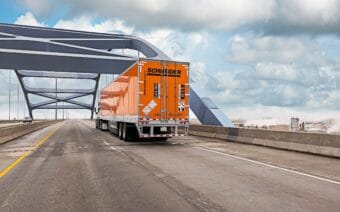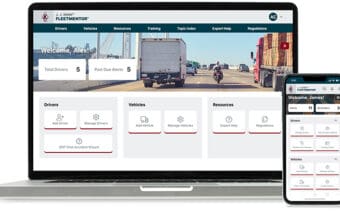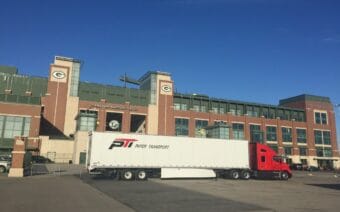
May 1, 2024
GREEN BAY – The Port of Green Bay will see an expansion this year as work begins at the site of the former Wisconsin Public Service Pulliam Power Plant.
“This is the start of a transformative project for the Port of Green Bay,” Mark Walter, business development manager for the port, said at a symposium held late last month.
Walter said the port purchased the former power plant – which sits at the mouth of the Fox River – in January 2022 for $2.7 million with help from a $500,000 Wisconsin Economic Development Corp. grant.
The 44-acre parcel, he said, has deep water access, rail access and is close to Interstate 43.
As part of the estimated $53-million project, Walter said the port plans to build an access road to the site and add security fencing between the site and the adjoining WPS property in 2024.
The overall construction project, he said, will be divided into five phases with a completion goal in 2027.
“We will eventually have a level property once we fill in several areas,” he said.
Once complete, Walter said the project is estimated to increase the port’s economic activity by $87 million in the first five years.
Site improvements include installing a dock wall along the bulkhead in the river, adding fill behind the bulkhead, filling in an existing slip and cooling water discharge channel and dredging to the shipping channel depth of 26 feet.
When complete, Walter said ships will be able to load and unload cargo at the new port.
“This project has a cost-benefit of 2 to 1,” Walters said. “There are multiple benefits, including avoiding traffic delays due to bridge lifts, getting freight trucks off the road, which lowers emissions, and enhanced safety by getting those trucks off the road.”
Walter said the port expansion is a collaborative effort involving the county, city, state, federal government and private industries.

Dozens of city, county and state leaders gathered late last month for the 2024 Port Symposium in Green Bay. Submitted Photo
The project, he said, currently has a $22-million funding gap.
“We originally thought we could do the project for $30 million, but costs have increased as they have in other areas of the economy,” he said.
Walter said they will find out in June if the project receives a $25 million U.S. Department of Transportation RAISE grant.
Another part of the project, Walter said, includes moving C. Reiss Coal Co.’s coal pile from its current location near the Mason Street Bridge to a less visible location.
That land, he said, would be redeveloped, including 10 acres for housing and 20 acres for a new port site.
City and county officials, as well as Gov. Tony Evers, attended last month’s symposium to show their support for the port, including the expansion.
Sen. Tammy Baldwin appeared via video to discuss some of the grants the port has received for the project.
Economic impact
Walter’s presentation was one of several at the symposium that looked at the port’s impact on the region, projects being completed by individual terminal operators and other factors, such as the impact of water levels on shipping in the Great Lakes and the St. Lawrence Seaway.
The Port of Green Bay, Tom Klimek – president of the Harbor Commission – said continues to be a major economic driver in Brown County.
According to the latest economic impact study, the port generated $217.3 million in economic activity in 2022 – a $70 million increase since 2017.
Klimek said the port also supports 1,620 jobs.
Shipping increased by 3% in 2022 to about 1.4 million metric tons in 2023.
“From the port, companies can ship to the rest of the world,” he said.
Green Bay is the western-most port on Lake Michigan and has 14 active terminal operators located along three miles of the Fox River involved in shipping commodities: Ace Marine, C. Reiss Coal Company, Construction Resources Management, Flint Hills Resources, Fox River Terminals, Georgia-Pacific, Graymont, GLC Minerals, KK Integrated Logistics, Holcim Inc., Procter & Gamble, RGL, Sanimax, St. Marys Cement and U.S. Venture.
Port businesses handle dry bulk commodities, such as coal, limestone and salt; bulk liquids, like petroleum products, liquid asphalt and tallow; and break-bulk commodities, including wood pulp and forest products in addition to oversized cargo like machinery and wind tower components.
“Our port has what it needs to succeed – good infrastructure, good governance and access to great water,” Port Director Dean Haen said.
The 2024 shipping season kicked off March 10 this year – the earliest it has, Haen said, in the 25 years he’s been with the port.
“Factors that affect the shipping season include the weather, ice cover on the Great Lakes and the St. Lawrence Seaway and water conditions in other parts of the Great Lakes,” he said.
Terminal improvements
Two of the port’s tenants – Holcim and GLC Minerals – shared updates on projects they have been working on to improve their terminals.
Ryan Cluckey, district terminal manager, said cement producer Holcim recently completed a $13.2-million terminal upgrade and expansion project to modernize its Green Bay terminal.
The project, he said, was supported by a $1.2 million Harbor Assistance Grant from the Wisconsin Department of Transportation.

Green Bay is the western-most port on Lake Michigan and has 14 active terminal operators located along three miles of the Fox River. The Business News File Photo
The terminal connects regional customers to the company’s cement plant in Alpena, Michigan.
As part of the project, Cluckey said Holcim built a new 10,000-metric-ton silo to hold cement, including the company’s lower carbon cement customers can use to reduce the carbon footprints of their building projects.
“The change allows customers to access our cement 24 hours a day,” he said. “It improves efficiencies, creates a safer environment and increases our site capacity by 33%.”
As part of that project, the 1927 ST Crapo, which Cluckey said had been an iconic storage facility in the terminal, was removed.
“When we were moving that, people lined up to see it go,” he said.
The terminal’s dock area, Cluckey said, was also improved – a project that included dredging a deeper area to allow the facility to accommodate fully loaded tug barges with a couple thousand more metric tons of product per trip.
Since the site is south of the Mason Street Bridge, Cluckey said every shipment to the terminal requires all three downtown lift bridges to rise.
“If we can take in more cement with each trip, that means fewer overall trips and less disruption of car and pedestrian traffic,” he said.
Cluckey said Holcim also installed a new dock and gangway and replaced mooring bollards.
Ken Przybyla, vice president of operations of GLC Minerals, said the carbonates and calcium sulfate producer has completed upgrades of its own.
Przybyla said the company purchased seven acres from the port (which was part of the 44 acres purchased from WPS).
One of the major upgrades GLC Minerals made, he said, includes changing the slip so vessels no longer need to back in but rather can just pull up – which he said makes it safer and easier to move product.
Przybyla also said the project allows the company to store all of its products on one side of the river, cutting down on over-the-road truck traffic.
“We look forward to continued port growth,” he said.
 Welcome to Camp Elsewhere – a woodsy retreat
Welcome to Camp Elsewhere – a woodsy retreat Did somebody say pickleball?
Did somebody say pickleball?








